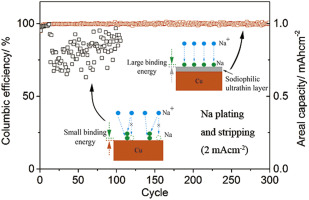Nano Energy ( IF 16.8 ) Pub Date : 2018-03-16 , DOI: 10.1016/j.nanoen.2018.03.039 Shuai Tang , Zhi Qiu , Xue-Yin Wang , Yu Gu , Xia-Guang Zhang , Wei-Wei Wang , Jia-Wei Yan , Ming-Sen Zheng , Quan-Feng Dong , Bing-Wei Mao

|
Sodium metal is a very promising anode for energy storage and conversion in the post lithium ion battery era because of its high capacity (1166 mA h g−1), earth-abundance and low cost. However, the sodium metal anode suffers from unstable plating and stripping cycling and thus low Coulombic efficiency. One of the important reasons for the situation is the high overpotential for sodium nucleation and thus non-uniform deposition and even dendrites growth. Herein we report a facile method by introducing a “sodiophilic” layer of Au-Na alloy onto the Cu substrate that acts as the current collector to significantly reduce the nucleation overpotential. Thus, the sodium metal can be plated on and stripped from the modified current collector with good reversibility. The average Coulombic efficiency maintains 99.8% at the current of 2.0 mA cm−2 for 300 cycles. As a proof of concept, an anode-free full cell consisting of [email protected] and presodiated FeS2 was assembled. Our work demonstrates the great importance of sodiophilic modification of substrate to the deposition process for sodium metal battery.
中文翻译:

亲钠层可实现室温钠金属阳极
金属钠由于其高容量(1166 mA h g -1),地球资源丰富且价格低廉。然而,钠金属阳极遭受不稳定的镀覆和汽提循环,因此库仑效率低。造成这种情况的重要原因之一是钠成核的过高电势,从而导致沉积不均匀甚至枝晶生长。本文中,我们通过在铜基板上引入Au-Na合金的“嗜碱”层作为一种集电器,以显着减少成核超电势的方法,报道了一种简便的方法。因此,可以以良好的可逆性将钠金属镀在修饰的集电器上或从修饰的集电器上剥离。在300 mA的电流下,在2.0 mA cm -2的电流下,平均库仑效率保持99.8%。作为概念验证,无阳极全电池由[受电子邮件保护]和预溶的FeS组成2已组装。我们的工作表明,对钠金属电池进行沉积过程对衬底进行亲油改性非常重要。











































 京公网安备 11010802027423号
京公网安备 11010802027423号